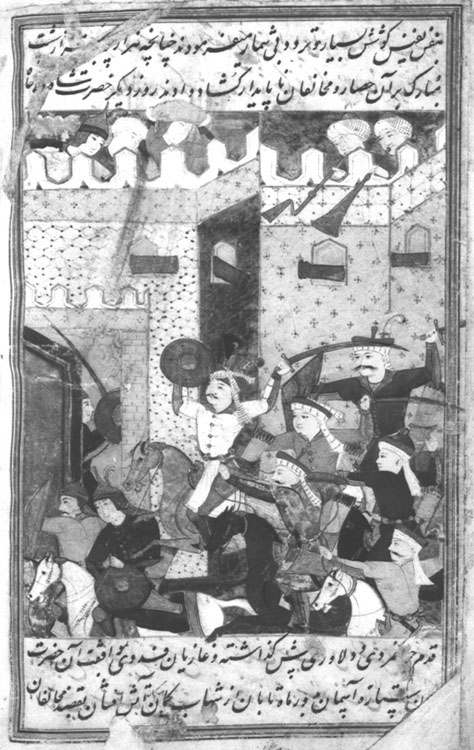Date of this event: 909/1504.
Following the defeat of Morād Beg in 908/1503 (cf. f.86), many Turkman nobles, feeling their position in Persian Iraq no longer secure, took refuge in the mountains of Rostamdār at the court of Emir Ḥoseyn Kiā Čolāvi. Encouraged by these Turkman emigres, and feeling his domain impregnable, Emir Ḥoseyn adopted a belligerent attitude towards Esmāʿil, and made incursions into Persian Iraq. In response, Esmāʿil sent a detachment of troops to Rostamdār, but they were defeated and their commander killed. In the spring of 909/1504 Esmāʿil launched a major campaign against Emir Ḥoseyn, which consisted of the siege and capture of three main fortresses: Gol-e Ḵandān, Firuzkuh, and Ostā. This painting depicts the battle for the Firuzkuh fort. According to the text, Esmāʿil and the qezelbāš brought the fortress under siege, but it was not until Maḥmud Beg Qājār found an opening in the fortress wall through which the inhabitants obtained their water, that the tide of battle was turned. With a detachment of troops, Maḥmud Beg entered the fortress, surprised the defenders, and gained control of the first floor. This prompted the commander, Emir ʿĀli Kiā, and most of his men to surrender, and their lives were spared. Others in the fort continued the battle and were subdued and killed.
Shah Esmāʿil, with arms raised holding a sword and a shield, is at the forefront of his troops, near the center. He is surrounded by five fierce mounted ǧāzi’s brandishing swords or shooting arrows at the fleeting enemy. Two opponents in the left foreground are almost trampled by their advance. Behind the mass of advancing Safavids and fleeting enemy is a formidable fortress, with embattlements at the top, and cannons pointed out of the pedimented openings just below the parapet. An entrance, on the left with the door ajar, reveals a soldier with sword and shield. At the top of the fortification, behind the crenelations, are five defenders: two trumpeters, one archer, and another about to drop a large boulder on the attackers below.
Painting: 15.2 x 12.2 cm. Two lines of text above and below the painting. Frame encloses painting and text. Two smears in the upper left; the lower right corner of the page with part of the frame and a few characters of text is missing; a tear in the bottom left. No signs of retouching. The painting is signed in the lower margin in Moʿin’s hand: raqam zad kamina moʿin-e moṣavver. Not dated.
Painting references:
Unpublished.
Text references:
See Savory, SA_1979, p.47-48 for this event in the History of Shah ʿĀbbās.
Morton, Pembroke_1990, pp.189-91.
Robert Eng
Last updated: November 22, 2010
